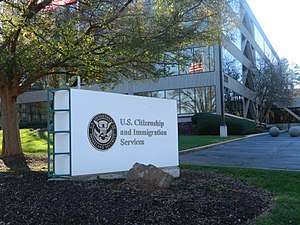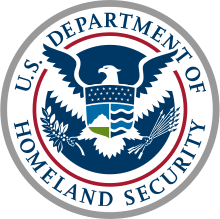United States Citizenship and Immigration Services
U.S. Citizenship and Immigration Services (USCIS)[3] is an agency of the United States Department of Homeland Security (DHS) that administers the country's naturalization and immigration system. It is a successor to the Immigration and Naturalization Service (INS), which was dissolved by the Homeland Security Act of 2002 and replaced by three components within the DHS: USCIS, Immigration and Customs Enforcement (ICE), and Customs and Border Protection (CBP).
 USCIS Logo | |
| Agency overview | |
|---|---|
| Formed | March 1, 2003 |
| Jurisdiction | Federal government of the United States |
| Headquarters | 111 Massachusetts Avenue NW Washington, D.C., U.S. |
| Employees | 16,654 (2017)[1] |
| Annual budget | $3.219 billion (2014)[2] |
| Agency executive |
|
| Parent agency | United States Department of Homeland Security |
| Key documents | |
| Website | www |
USCIS performs many of the duties of the former INS, namely processing and adjudicating various immigration matters, including applications for work visas, asylum, and citizenship. Additionally, the agency is officially tasked with safeguarding national security, eliminating immigration case backlogs, and improving efficiency. USCIS is currently headed by an Acting Director, Mark Koumans, after the appointment of his predecessor Ken Cuccinelli was found to be unlawful.[4][5]
Functions

USCIS is charged with processing immigrant visa petitions, naturalization applications, asylum applications, applications for adjustment of status (green cards), and refugee applications. It also makes adjudicative decisions performed at the service centers, and manages all other immigration benefits functions (i.e., not immigration enforcement) performed by the former INS. Other responsibilities of the USCIS include:
- Administration of immigration services and benefits
- Issuing employment authorization documents (EAD)
- Adjudicating petitions for non-immigrant temporary workers (H-1B, O-1, etc.)
While core immigration benefits functions remain the same as under the INS, a new goal is to process immigrants' applications more efficiently. Improvement efforts have included attempts to reduce the applicant backlog, as well as providing customer service through different channels, including the USCIS Contact Center with information in English and Spanish, Application Support Centers (ASCs), the Internet and other channels. The enforcement of immigration laws remains under Customs and Border Protection (CBP) and Immigration and Customs Enforcement (ICE).
USCIS focuses on two key points on the immigrant's journey towards civic integration: when they first become permanent residents and when they are ready to begin the formal naturalization process. A lawful permanent resident is eligible to become a citizen of the United States after holding the Permanent Resident Card for at least five continuous years, with no trips out of the United States lasting 180 days or more. If, however, the lawful permanent resident marries a U.S. citizen, eligibility for U.S. citizenship is shortened to three years so long as the resident has been living with the spouse continuously for at least three years and the spouse has been a resident for at least three years.
Forms
USCIS handles all forms and processing materials related to immigration and naturalization. This is evident from USCIS' predecessor, the INS, (Immigration and Naturalization Service) which is defunct as of March 1, 2003.[6]
USCIS currently handles two kinds of forms: those relating to immigration, and those related to naturalization. Forms are designated by a specific name, and an alphanumeric sequence consisting of one letter, followed by two or three digits. Forms related to immigration are designated with an I (for example, I-551, Permanent Resident Card) and forms related to naturalization are designated by an N (for example, N-400, Application for Naturalization).
Immigration courts and judges
The United States immigration courts and immigration judges and the Board of Immigration Appeals which hears appeals from them, are part of the Executive Office for Immigration Review (EOIR) within the United States Department of Justice. (USCIS is part of the Department of Homeland Security.)[7]
Operations
Internet presence
USCIS' official website is USCIS.gov. The site was redesigned in 2009 and unveiled on September 22, 2009.[8]
The redesign made the web page interface more like the Department of Homeland Security's official website. The last major redesign before 2009 took place in October 2006.
Also, USCIS runs an online appointment scheduling service known as INFOPASS. This system allows people with questions about immigration to come into their local USCIS office and speak directly with a government employee about their cases. As of early 2019, however, many USCIS field offices are doing away with on-demand INFOPASS appointments.
Funding
Unlike most other federal agencies, USCIS is funded almost entirely by user fees.[9] Under President George W. Bush's FY2008 budget request, direct congressional appropriations made about 1% of the USCIS budget and about 99% of the budget was funded through fees. The total USCIS FY2008 budget was projected to be $2.6 billion.[10]
Staffing
USCIS consists of approximately 19,000 federal employees and contractors working at 223 offices around the world.[11]
Mission statement
USCIS's mission statement was changed on February 23, 2018. Among other changes, the phrase "America's promise as a nation of immigrants" was eliminated, a move that drew criticism from immigration rights advocates and praise from those in favor of tighter restrictions on immigration.[12]
See also
- Visa policy of the United States
- H-1B Visa
- Permanent residence (United States) ("Green card")
- Visa Waiver Program
- The other two major U.S. immigration-related agencies:
References
![]()
- "Citizenship and Immigration Services Employment - September 2017". United States Office of Personnel Management. Retrieved 24 January 2018.
- "Budget-in-Brief: Fiscal Year 2015" (PDF). U.S. Department of Homeland Security. Retrieved 2014-11-12.
- "Our History".
- Kanno-Youngs, Zolan (2020-03-01). "Cuccinelli's Appointment to Immigration Post Is Illegal, Judge Rules". The New York Times. ISSN 0362-4331. Retrieved 2020-03-02.
- Kight, Stef W. "Federal judge rules Ken Cuccinelli unlawfully ran immigration agency". Axios. Retrieved 2020-03-02.
- Immigration and Naturalization Service
- "The Citizenship Surge". The New York Times. Nov 27, 2007. Retrieved April 16, 2017.
- "Secretary Napolitano and USCIS Director Mayorkas Launch Redesigned USCIS Website" (Press release). United States Department of Homeland Security. September 22, 2009. Retrieved April 10, 2010.
- Khatri, Prakash (11 January 2007). "Citizenship and Immigration Services Ombudsman's 2007 Annual Report" (PDF). United States Department of Homeland Security: 46–47. Retrieved 13 June 2019.
- "President's FY 2008 Budget Request for USCIS Focuses on Building an Immigration Service for the 21st Century" (PDF). USCIS FY2008. United States Department of Homeland Security: 2. 5 February 2007. Archived from the original (PDF) on 26 October 2009. Retrieved 13 June 2019.
- "About Us".
- Jordan, Miriam (2018-02-22). "Is America a 'Nation of Immigrants'? Immigration Agency Says No". The New York Times. Retrieved February 24, 2018.
External links
| Wikimedia Commons has media related to United States Citizenship and Immigration Services. |
